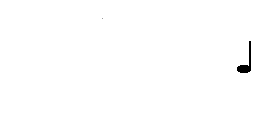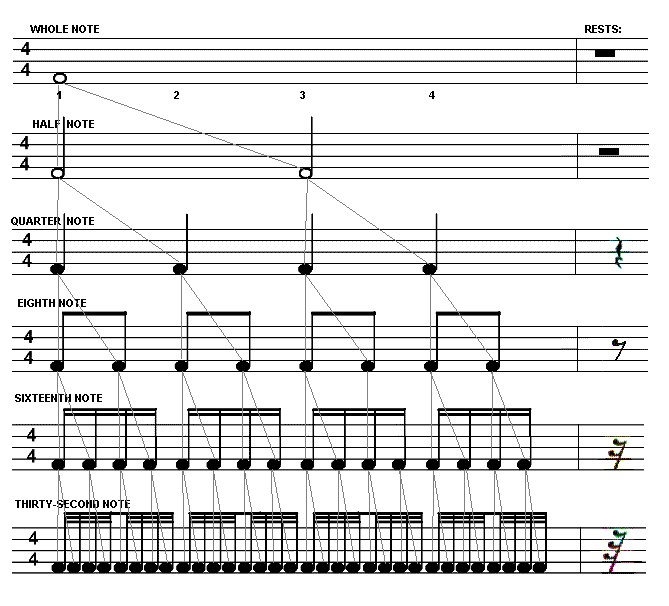Welcome to my class, here you will study the art of music my most pride subject, so I will be kind enough to teach you most of what you need to know.
Lesson 1
Reading Music
Not knowing how to read music is a disaster so to help you is me. Here will show you how to read on both Treble Clef and Bass Clef, not bass as in the fish but bass as in base.

The fancy symbol to the left of the top 5 sets of lines and 4 spaces is the Treble Clef to be specific the G Treble Clef
And the bottom symbol is the Bass Clef to be specific F Bass Clef.
A with 5 lines and 4 spaces is called a staff which is just a musical term meaning 5 lines and 4 spaces with a clef.
Notice how there are lines under the notes these lines are called "Ledger Lines". Ledger Lines, are lines that are either above or below the staff but keeps going in the same order as it is on the staff it just shows either higher or lower notes. Can be as many lines as needed.
Sharps # & Flats b
Sharps: A musical term used to express a half step or tone above a single note. Ex: C# B# E# F# G#, can be any note.
Flat: A musical term used to express a half step or tone below a single note. Ex: Gb Fb Ab Db, can be any note.
A sharp looks like a number sign and flat looks like a fancy italicized lower case b
Lesson 2
Musical Notation
Reading music requires you to know your notes

This is a Whole note which gets four beats

This is a half not which gets 2 beats

This is a quarter note it gets 1 beat
(Note that a quarter and half differ from the shaded in circle)

This is an eighth note gets half the beat of a quarter note
There are more types of note which I will show you later on in the lesson but these are the basic notes
When counting in music you are led by a metronome either in front of you or in your head and this "Metronome" keeps the timing or the steady beat
A whole note is held for four beats meaning it is not let off until the forth beat has ended.
A half note is held for 2 beats and is not let off until the second beat has ended.
A quarter note is held for 1 beat and is not let off until the first beat has ended.
An eighth note is a fast note, and is held for half the value of a quarter note so when this is played count one and two and (And is a beat for an eighth including a number)

Trying clapping this during the week so it could help you keep timing and know how to keep the beat of each of these notes

Lesson 1
Reading Music
Not knowing how to read music is a disaster so to help you is me. Here will show you how to read on both Treble Clef and Bass Clef, not bass as in the fish but bass as in base.

The fancy symbol to the left of the top 5 sets of lines and 4 spaces is the Treble Clef to be specific the G Treble Clef
And the bottom symbol is the Bass Clef to be specific F Bass Clef.
A with 5 lines and 4 spaces is called a staff which is just a musical term meaning 5 lines and 4 spaces with a clef.
Notice how there are lines under the notes these lines are called "Ledger Lines". Ledger Lines, are lines that are either above or below the staff but keeps going in the same order as it is on the staff it just shows either higher or lower notes. Can be as many lines as needed.
Sharps # & Flats b
Sharps: A musical term used to express a half step or tone above a single note. Ex: C# B# E# F# G#, can be any note.
Flat: A musical term used to express a half step or tone below a single note. Ex: Gb Fb Ab Db, can be any note.
A sharp looks like a number sign and flat looks like a fancy italicized lower case b
Sharp = #
Flat = b
Flat = b
Lesson 2
Musical Notation
Reading music requires you to know your notes

This is a Whole note which gets four beats

This is a half not which gets 2 beats

This is a quarter note it gets 1 beat
(Note that a quarter and half differ from the shaded in circle)

This is an eighth note gets half the beat of a quarter note
There are more types of note which I will show you later on in the lesson but these are the basic notes
When counting in music you are led by a metronome either in front of you or in your head and this "Metronome" keeps the timing or the steady beat
A whole note is held for four beats meaning it is not let off until the forth beat has ended.
A half note is held for 2 beats and is not let off until the second beat has ended.
A quarter note is held for 1 beat and is not let off until the first beat has ended.
An eighth note is a fast note, and is held for half the value of a quarter note so when this is played count one and two and (And is a beat for an eighth including a number)

Trying clapping this during the week so it could help you keep timing and know how to keep the beat of each of these notes



